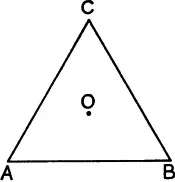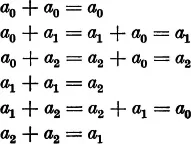
eBook - ePub
An Introduction to the Theory of Groups
Paul Alexandroff, Hazel Perfect, G.M. Petersen
This is a test
Partager le livre
- 128 pages
- English
- ePUB (adapté aux mobiles)
- Disponible sur iOS et Android
eBook - ePub
An Introduction to the Theory of Groups
Paul Alexandroff, Hazel Perfect, G.M. Petersen
Détails du livre
Aperçu du livre
Table des matières
Citations
À propos de ce livre
This introductory exposition of group theory by an eminent Russian mathematician is particularly suited to undergraduates, developing material of fundamental importance in a clear and rigorous fashion. The treatment is also useful as a review for more advanced students with some background in group theory.
Beginning with introductory examples of the group concept, the text advances to considerations of groups of permutations, isomorphism, cyclic subgroups, simple groups of movements, invariant subgroups, and partitioning of groups. An appendix provides elementary concepts from set theory. A wealth of simple examples, primarily geometrical, illustrate the primary concepts. Exercises at the end of each chapter provide additional reinforcement.
Beginning with introductory examples of the group concept, the text advances to considerations of groups of permutations, isomorphism, cyclic subgroups, simple groups of movements, invariant subgroups, and partitioning of groups. An appendix provides elementary concepts from set theory. A wealth of simple examples, primarily geometrical, illustrate the primary concepts. Exercises at the end of each chapter provide additional reinforcement.
Foire aux questions
Comment puis-je résilier mon abonnement ?
Il vous suffit de vous rendre dans la section compte dans paramètres et de cliquer sur « Résilier l’abonnement ». C’est aussi simple que cela ! Une fois que vous aurez résilié votre abonnement, il restera actif pour le reste de la période pour laquelle vous avez payé. Découvrez-en plus ici.
Puis-je / comment puis-je télécharger des livres ?
Pour le moment, tous nos livres en format ePub adaptés aux mobiles peuvent être téléchargés via l’application. La plupart de nos PDF sont également disponibles en téléchargement et les autres seront téléchargeables très prochainement. Découvrez-en plus ici.
Quelle est la différence entre les formules tarifaires ?
Les deux abonnements vous donnent un accès complet à la bibliothèque et à toutes les fonctionnalités de Perlego. Les seules différences sont les tarifs ainsi que la période d’abonnement : avec l’abonnement annuel, vous économiserez environ 30 % par rapport à 12 mois d’abonnement mensuel.
Qu’est-ce que Perlego ?
Nous sommes un service d’abonnement à des ouvrages universitaires en ligne, où vous pouvez accéder à toute une bibliothèque pour un prix inférieur à celui d’un seul livre par mois. Avec plus d’un million de livres sur plus de 1 000 sujets, nous avons ce qu’il vous faut ! Découvrez-en plus ici.
Prenez-vous en charge la synthèse vocale ?
Recherchez le symbole Écouter sur votre prochain livre pour voir si vous pouvez l’écouter. L’outil Écouter lit le texte à haute voix pour vous, en surlignant le passage qui est en cours de lecture. Vous pouvez le mettre sur pause, l’accélérer ou le ralentir. Découvrez-en plus ici.
Est-ce que An Introduction to the Theory of Groups est un PDF/ePUB en ligne ?
Oui, vous pouvez accéder à An Introduction to the Theory of Groups par Paul Alexandroff, Hazel Perfect, G.M. Petersen en format PDF et/ou ePUB ainsi qu’à d’autres livres populaires dans Matematica et Teoria degli insiemi. Nous disposons de plus d’un million d’ouvrages à découvrir dans notre catalogue.
Informations
Sujet
MatematicaSous-sujet
Teoria degli insiemiChapter I
THE GROUP CONCEPT
§ 1. Introductory examples
1. Operations with whole numbers
The addition of whole numbers * satisfies the following conditions, which we call axioms of addition and which are of very great importance for all that follows:
I. Two numbers can be added together (i.e. to any two arbitrary numbers a and b there corresponds a uniquely determined number, which we call their sum: a + b).
II. The Associative Law:
For any three arbitrary numbers a, b, c we have the following identity

III. Among the numbers there is a uniquely determined number 0, the zero, which is such that for every number a the relation

is satisfied.
IV. To every number a there corresponds a so-called inverse (or negative) number —a, which has the property that the sum a + (—a) is equal to zero:

Finally yet another important condition is satisfied.
V. The Commutative Law:

2. The rotations of an equilateral triangle
We show that it is possible to add not only numbers but also many other kinds of things, and that the above conditions remain satisfied.
First Example.—We consider all possible rotations of an equilateral triangle ABC about its centroid 0 (fig. 1). We agree to call two rotations identical if they only differ from one another by a whole number of complete revolutions (and therefore by an integral multiple of 360°*). We see without difficulty that of all possible rotations of the triangle only three rotations send it into coincidence with itself, namely, the rotations through 120°, 240°, and the so-called zero rotation, which leaves all the vertices unchanged and hence also all the sides of the triangle. The first rotation sends the vertex A into the vertex B, the vertex B into the vertex C, the vertex C into the vertex A (we say that it permutes cyclically the vertices A, B, C). The second rotation sends A into C, B into A, C into B, and therefore permutes A,C,B cyclically.

Fig. 1
Now we introduce the following natural definition: The addition of two rotations means their successive application, the first rotation followed by the second. If we add the rotation through 120° to itself, then the result is the rotation through 240°; if we add to it the rotation through 240°, then the result is the rotation through 360°, the zero rotation. Two rotations through 240° result in the rotation through 480° = 360° + 120°; their sum is therefore the rotation through 120°. If we denote the zero rotation by a0, the rotation through 120° by a1, the rotation through 240° by a2, then we obtain the following relations:

Thus the sum of any two of the rotations a0, a1, a2 is defined and is again one of the rotations a0, a1, a2 We easily convince ourselves that this addition satisfies the associative law and evidently also the commutative law. Further, there exists among these rotations a0, a1, a2 a zero rotation a0 which satisfies the...